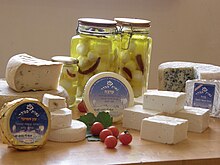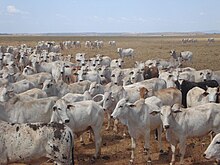Animal product


An animal product is any material derived from the body of a non-human animal.[1] Examples are fat, flesh, blood, milk, eggs, and lesser known products, such as isinglass and rennet.[2]
Animal by-products, as defined by the USDA, are products harvested or manufactured from livestock other than muscle meat.[3] In the EU, animal by-products (ABPs) are defined somewhat more broadly, as materials from animals that people do not consume.[4] Thus, chicken eggs for human consumption are considered by-products in the US but not France; whereas eggs destined for animal feed are classified as animal by-products in both countries. This does not in itself reflect on the condition, safety, or wholesomeness of the product.
Animal by-products are
The word animals includes all species in the
Increased production and consumption over the past 50 years has led to widespread environmental and animal welfare impacts. These range from being linked to 80% of Amazonian deforestation[6] to the welfare implications of using chick culling shredders on live day old-chicks for 7 billion of them each year.[7]
Several popular diet patterns prohibit the inclusion of some categories of animal products and may also limit the conditions of when other animal products may be permitted. This includes but not limited to secular diets; like, vegetarian, pescetarian, and paleolithic diets, as well as religious diets, such as kosher, halal, mahayana, macrobiotic, and sattvic diets. Other diets, such as vegan-vegetarian diets and all its subsets exclude any material of animal origin.[8] Scholarly, the term animal source foods (ASFs) has been used to refer to these animal products and by-products collectively.[9]
In international trade legislation, the terminology products of animal origin (POAO) is used for referring to foods and goods that are derived from animals or have close relation to them.[10]
Slaughterhouse waste

Slaughterhouse waste is defined as animal body parts cut off in the preparation of carcasses for use as food. This waste can come from several sources, including slaughterhouses, restaurants, stores and farms. In the UK, slaughterhouse waste is classed as category 3 risk waste in the Animal By-Products Regulations, with the exception of condemned meat which is classed as category 2 risk.
By-products in pet food
The leftover pieces that come from the process of stripping meat from animals tends to get used for different purposes. One of them is to put these parts into pet food.
Effects of production
Environmental impact

Animal husbandry has a significant impact on the world environment. Both production and consumption of animal products have increased rapidly. Over the past 50 years, meat production has tripled, whereas the production of dairy products doubled and that of eggs almost increased fourfold.[13] Meanwhile, meat consumption has nearly doubled worldwide. Developing countries had a surge in meat consumption, particularly of monogastric livestock.[14] Being a part of the animal–industrial complex, animal agriculture drives climate change, ocean acidification, and biodiversity loss, and kills 60 billion animals annually.[15] It uses between 20 and 33% of the world's fresh water,[16] Livestock, and the production of feed for them, occupy about a third of the Earth's ice-free land.[17] Livestock production contributes to species extinction, desertification,[18] and habitat destruction.[19] and is the primary driver of the Holocene extinction.[20][21][22][23][24] Some 70% of the agricultural land and 30% of the total land surface of the Earth is involved directly or indirectly in animal agriculture.[25] Habitat is destroyed by clearing forests and converting land to grow feed crops and for grazing, while predators and herbivores are frequently targeted because of a perceived threat to livestock profits; for example, animal husbandry causes up to 91% of the deforestation in the Amazon region.[26] In addition, livestock produce greenhouse gases. Cows produce some 570 million cubic metres of methane per day,[27] that accounts for 35 to 40% of the overall methane emissions of the planet.[28] Further, livestock production is responsible for 65% of all human-related emissions of nitrous oxide.[28][29][30]
Animal welfare
Since the 18th century, people have become increasingly concerned about
Additives
- Carmine, derived from crushed cochineal beetles, is a red or purple substance commonly used in food products.[37] It is common in food products such as juice, candy, and yogurt.[38][39] The presence of carmine in these products has been a source of controversy.[40][41] One major source of controversy was the use of carmine in Starbucks frappuccinos.[42][43] Carmine is an allergen according to the FDA.[44] It takes about 70,000 female insects to produce a pound of dye.[45]
- and dietary supplements)
- Rennet (commonly used in the production of cheese)
- Shellac (commonly used for food dye, food glaze and medicine glaze)
- Swiftlet's nest (made of saliva)
Food
- Ambrosia, also known as “bee bread” (which is made from both plant pollen and the insect’s secretions)
- Arachnids
- Blood as taboo food)
- Bone, including bone char, bone meal, etc.
- Broths and stocks are often created with animal fat, bone, and connective tissue
- Caviar
- Casein (found in milk and cheese)
- Civet oil (food flavoring additive)
- Dairy products (e.g., milk, cheese, yogurt, etc.)
- , etc.)
- Escargot pearls
- Fat (e.g., lard, lardon, schmaltz, suet, tallow, etc.)
- Gelatin (used to make candy, ice cream, and marshmallows)
- Hard roe (as food is used as a raw or cooked ingredient in various dishes)
- Honey (including comb honey products)
- Honeydew
- clarificationof beer and wine)
- Insects (some edible insects are consumed whole or made into a powder, like cricket flour. The flours are then used to make products like insect fitness bars or burger patties.)
- Kopi luwak and Black Ivory Coffee
- Meat (which includes fish, shellfish, sauces made from them, and poultry in addition to livestock, game, and "exotic dishes" made from amphibians or reptiles)
- Offal
- Skins (remaining skin scraps as a by-product of meat production or fat rendering are made profitable by being fried/roasted and sold as snacks, like; scratchings, and rambak)
- Snake wine (also used as medicine)
- Soft roe, also known as “white roe” (commonly fried, used as an ingredient in a larger dish, or used as a condiment in some European and Asian countries)
- Whey (found in cheese and added to many other products)
Non-food animal products
- Animal fiber
- Ambergris
- Beeswax
- Bear bile(used to make medicine)
- blood substitutes (blood used for transfusionsis always human in origin, though some blood substitutes are made from animal sources. Many diagnostic laboratory tests use animal or human sourced reagents)
- Casein (used in plastics, clothing, cosmetics, adhesives and paint)
- Castoreum (secretion of the beaver used in perfumes and possibly in food flavoring)
- Civet oil
- Coral rock (Precious coral in particular is beloved for jewelry making)
- Donkey milk
- Egg oil (used in skin care products as a preservative and as skin conditioning agent)
- maintainbeauty.)
- Ejaculate (used in artificial insemination)
- Feathers
- Fishmeal
- Fur
- Traditional Chinese Medicine)
- Guano
- Hide
- Horse oil (used in East Asian skincare masks and creams for similar purposes as emu oil.)
- antlersetc.
- Ivory
- Lanolin
- Limulus amebocyte lysate (a chemical in horseshoe crab blood used to detect bacterial endotoxin)
- Leather
- Manure
- lashes
- Mink oil
- Musk
- Nautilus (decorative shell or pearl alternative)
- Ovine Placenta
- Pearl or mother of pearl (Treated as a precious gem for making jewelry or adorning clothing & accessories. Pearl powder is used as a natural skincare product for hydrating & healing the skin as well as lightening, brightening and maintaining youthfulness of the complexion)
- Royal jelly (used as a dietary supplement)
- Scales (fish scales are often used in makeup to impart a refractive & pearlescent finish)
- Silk
- Sponges
- Skunk oil
- Snail Mucin (used in topical medications and skincare products as a treatment for lesions and acne or as an antioxidant to brighten and hydrate the skin)
- Stearin
- Tallow, may be used in food and soap
- Tortoiseshell
- Urine
- antivenin)
- Whale oil
- Wool
See also
- Advanced meat recovery
- Biodegradable waste
- Boiling down
- Food quality
- Food safety
- List of waste types
- Meat extenders
- Mechanically separated meat
- Pink slime
- Potted meat food product
- Spam (food)
- Veganism as alternatives to animal products
References
- ^ Gilman, Daniel Coit; Peck, Harry Thurston; Colby, Frank Moore (1907). The New International Encyclopædia. Dodd, Mead & Co. p. 474.
- ^ Unklesbay, Nan. World Food and You. Routledge, 1992, p. 179ff.
- ^ "USDA ERS - Glossary". Archived from the original on February 2, 2017. Retrieved January 20, 2017.
- ^ "Animal by-products". Archived from the original on January 15, 2021. Retrieved January 20, 2017.
- ^ Ockerman, Herbert and Hansen, Conly L. Animal by-product processing & utilization. Technomic Publishing Company Inc., 2000, p. 1.
- ISSN 0959-3780.
- ISSN 0032-5791.
- ^ Stepaniak, Joanne. Being Vegan: Living with Conscience, Conviction, and Compassion. McGraw-Hill Professional, 2000, p. 7.
- .
- ^ "Animals and animal products: international trade regulations". Archived from the original on January 14, 2021. Retrieved August 6, 2018.
- ^ a b "Byproducts". talkspetfood.aafco.org. Archived from the original on August 24, 2021. Retrieved April 29, 2020.
- ^ "A big pawprint: The environmental impact of pet food". Clinical Nutrition Service at Cummings School. February 8, 2018. Archived from the original on October 28, 2021. Retrieved April 29, 2020.
- PMID 14672310.
- PMID 26117396.
- ^ Boscardin, Livia (July 12, 2016). "Greenwashing the Animal-Industrial Complex: Sustainable Intensification and Happy Meat". 3rd ISA Forum of Sociology, Vienna, Austria. ISAConf.confex.com. Retrieved August 10, 2021.
- ^ Mekonnen, Mesfin M.; Hoekstra, Arjen Y. (2012). "A Global Assessment of the Water Footprint of Farm Animal Products" (PDF). Water Footprint Network. Archived from the original (PDF) on March 11, 2015. Retrieved October 5, 2015.
- ^ "Livestock a major threat to environment". Food and Agriculture Organizations of the United Nations. Archived from the original on March 28, 2008. Retrieved October 5, 2015.
- ISBN 978-0-12-747261-4.
- ^ "Unit 9: Biodiversity Decline // Section 7: Habitat Loss: Causes and Consequences". Annenberg Learner. Archived from the original on October 28, 2018. Retrieved June 18, 2020.
- hdl:11336/71342. Archived from the original(PDF) on December 15, 2019. Retrieved August 10, 2021.
- ^ Carrington, Damian (February 3, 2021). "Plant-based diets crucial to saving global wildlife, says report". The Guardian. Retrieved August 5, 2021.
- ^ McGrath, Matt (May 6, 2019). "Humans 'threaten 1m species with extinction'". BBC. Retrieved August 3, 2021.
- PMID 26231772.
- ^ Smithers, Rebecca (October 5, 2017). "Vast animal-feed crops to satisfy our meat needs are destroying planet". The Guardian. Retrieved October 5, 2017.
- S2CID 154306257.
- ISBN 978-0-8213-5691-3.
- ^ Ross, Philip (2013). "Cow farts have 'larger greenhouse gas impact' than previously thought; methane pushes climate change". International Business Times.
- ^ a b Steinfeld, H.; Gerber, P.; Wassenaar, T.; Castel, V.; Rosales, M.; de Haan, C. (2006). "Livestock's Long Shadow: Environmental Issues and Options". FAO. Retrieved December 13, 2017.
- S2CID 153809456.
- PMID 20374748.
- ^ Grandin, Temple (2013). "Animals are not things: A view on animal welfare based on neurological complexity" (PDF). Trans-Scripts 3: An Interdisciplinary Online Journal in Humanities And Social Sciences at UC Irvine. Archived from the original (PDF) on August 19, 2014.
- PMID 12839246.
- PMID 1778832.
- ^ Garner, R. (2005). Animal Ethics. Polity Press.
- ISBN 9780520049048.
- ^ "'This one has heat stress': the shocking reality of live animal exports". The Guardian. July 30, 2018.
- ^ Jones, Nathaniel Lee, Benji. "Yoplait strawberry yogurt is one of many foods colored with carmine, a dye made from crushed cochineal bugs". Business Insider. Archived from the original on January 24, 2022. Retrieved September 3, 2020.
{{cite web}}: CS1 maint: multiple names: authors list (link) - ISSN 1059-1028. Retrieved September 3, 2020.
- ^ Smale, Helen Soteriou and Will (April 28, 2018). "Why you may have been eating insects your whole life". BBC News. Archived from the original on November 27, 2021. Retrieved September 3, 2020.
- ^ "Berries Over Bugs! | Center for Science in the Public Interest". cspinet.org. July 24, 2013. Archived from the original on August 24, 2021. Retrieved September 3, 2020.
- ISSN 0926-860X.
- ^ "Cochineal and Starbucks: Actually, this dye is everywhere". Los Angeles Times. April 20, 2012. Archived from the original on August 24, 2021. Retrieved September 3, 2020.
- ^ Cruz, Kim Bhasin, Noelia de la. "Here's what you need to know about the ground-up insects that Starbucks puts in your Frappuccino". Business Insider. Archived from the original on November 9, 2021. Retrieved September 3, 2020.
{{cite web}}: CS1 maint: multiple names: authors list (link) - ^ "Why You Should Never, Ever Give Red Candies To Your Valentine". HuffPost. February 13, 2014. Archived from the original on June 28, 2021. Retrieved September 3, 2020.
- ^ "Is it true that some candies are coloured with insect extract?". Office for Science and Society. Archived from the original on August 24, 2021. Retrieved September 3, 2020.
Further reading
- Extensive list identifying animal-derived and vegan ingredients
- FDA Consumer Magazine: The Lowdown on Labels
- Heinz, G. & Hautzinger, P. "Meat Processing Technology" Archived February 7, 2019, at the Wayback Machine, Food and Agriculture Organization, 2007, accessed March 30, 2012.
- Leoci, R., Animal by-products (ABPs): origins, uses, and European regulations, Mantova (Italy): Universitas Studiorum, 2014. ISBN 978-88-97683-47-6
- Mian N Riaz, Riaz N Riaz, Muhammad M Chaudry. Halal Food Production, CRC Press, 2004. ISBN 1-58716-029-3
- Tsai, Michelle. "What's in a can of dog food?, Slate, March 19, 2007.
- Earthly Origin of Materials, is a material animal, vegetable, or mineral?

